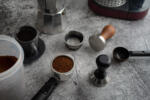Many different methods achieve coffee processing methods of the world’s top coffees. These processing techniques can be grouped into four categories: Wet Processing (Washed), Dry Processing (Natural, Sun-Dried), Pulped Natural Processing, and Semi-Washed Processing.
Table Of Contents
−- Impact of processing on coffee taste
- Wet Process
- Dry processing
- Pulped natural/semi-dry / honey process
- What is “Pulped Natural” coffee processing?
- Pulping the coffee to remove the outer skin
- Regions where pulped natural processing is used
- Characteristics of coffee with pulped natural processing
- Wet hulled / Semi washed
- What is “Semi-Washed” Coffee Processing?
- Pulping coffee
- Demucilaging, drying, and hulling
- Aquapulp coffee processing
- How do producers decide what process to use?
- What happens after the coffee is processed?
- Grading coffee
- Coffee silverskin
- Roasting coffee
- Conclusion
Farmers choose the processing method best suited for their climate and capabilities – whether they have a long, dry season to allow for dry processing or ample water supply because of a high tropical environment and how much labor they have access to.
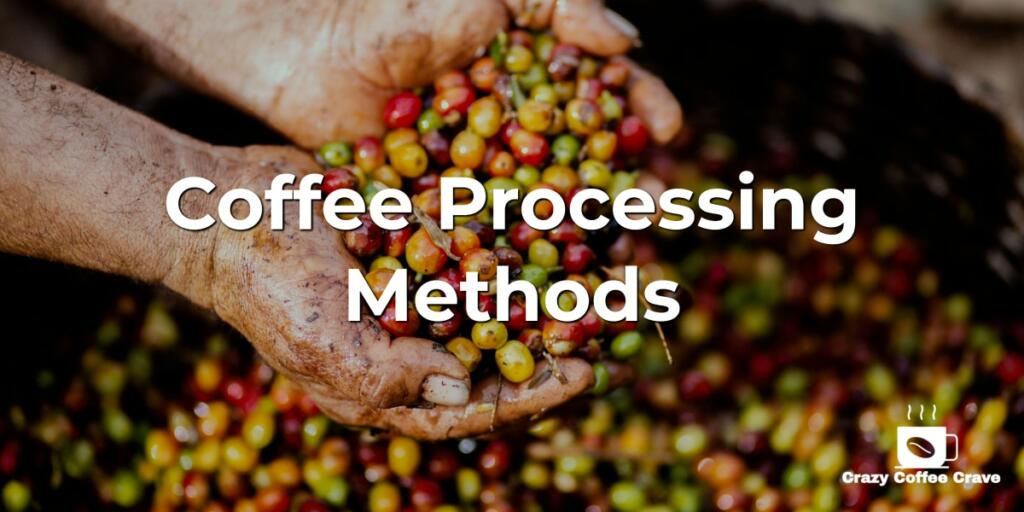
Here’s a quick guide to all of these coffee processing methods, with detailed explanations:
- Wet Processing involves washing the coffee beans of fruity material while the beans are still moist right after they are picked.
- Dry Processing involves drying the coffee cherry in the sun while regularly raking the beans free of any dried fruit.
- Pulped Natural Processing involves initially pulping the coffee without a fermentation stage as in Wet Processing, then drying the beans with much of the mucilage still attached.
- Semi-Washed Processing method, a demucilaging machine, is used to remove the coffee cherry’s skin and most of the mucilage.
- Aquapulp is another method that cleans the coffee cherry initially and has recently been adopted by many areas that formerly used wet processing.
Once the coffee beans are processed, they are usually bagged in 100-pound, 132-pound, or 154-pound coffee sacks and sold on the world market as green coffee beans (milled but not yet roasted).
Impact of processing on coffee taste
The way coffee is processed a significant impact on its taste. Haphazard processing can leave a lingering chalky taste on the tongue, while well-executed methods produce a delicious, smooth flavor. Each method of processing has its unique approach and produces different finished products in terms of taste, aroma, and cost.
Unwashed coffee, for example, has a heavier body and produces a complex and smooth taste. On the other hand, washed coffee has a cleaner taste and is less likely to have a sour or bitter aftertaste. Ultimately, the type of processing used affects the content of bioactive and volatile compounds in specialty coffees, making it important to choose a method that produces the desired flavor.
Wet Process
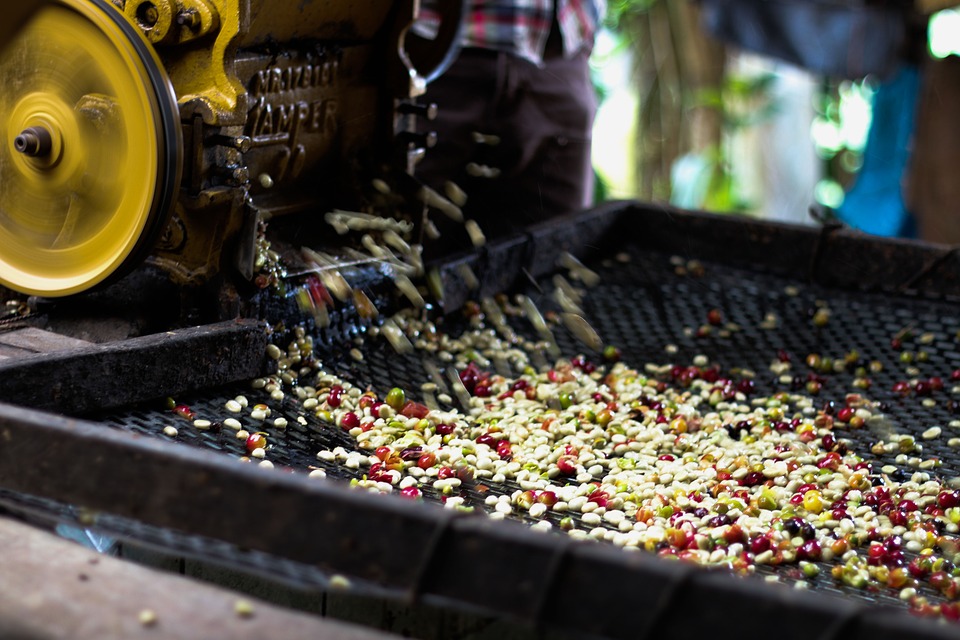
The wet processing method (washed) involves soaking the coffee cherries and allowing fermentation to separate the cherry from the bean – or it can be run through a mechanical depulper to remove the coffee cherries. Once the green coffee is removed, they’re washed to remove residue and placed outside to dry on a patio or raised beds.
The flavor of the resulting coffee is more “pure” than other methods – unaffected by the coffee cherry.
Coffee suppliers use different processing methods, and the flavor and fragrance required for the final product depend on where the coffee is produced.
Coffee processing is a critical step in making coffee for those who don’t know where coffee fruits are converted into the ultimate commodity coffee beans.
Using the dry processing system in countries with heavy rain and high air humidity is impossible. So coffee farmers from India, Indonesia, and Vietnam have used different wet processing methods.
Because the wet processing method is quite invasive compared to dry processing, it is only used from Arabica beans for coffee forms. Robusta coffee beans are not processed with this system because of their low quality, low final price, and low profit.
The main characteristic of the wet process is that the pulp and all the skins in the coffee fruit are discarded before drying the beans.
This is a fully automated approach that requires many steps:
- First, clean and sort the coffee berries, scraping away any soil, leaves, overripe berries, and so on.
- In the second phase, coffee beans are passed through numerous machines that remove the pulp and meat from the coffee bean.
- Coffee beans will be placed in a big water tank containing natural enzymes for 24-36 hours. Enzymes destroy anything not removed during the washing and pulping cycles during this period (the fermentation process).
- Coffee beans are cleaned with clean water during fermentation and dispatched to be cooled. The drying process is complete when the coffee moisture level at the start of the procedure is 12.5 percent rather than 60 percent.
- Unlike the first cleaning stage, this procedure only cleans coffee beans if there are remnants or processing after one last wash. This stage, also called hulling, is employed in the dry process.
Wet coffee flavor system and fragrance
Using the wet method, coffee beans usually produced have a cleaner color and appearance. But, of course, flavor and aroma are essential to every coffee bean. The wet coffee cycle’s smoother, healthier, and clearer taste (known as light coffee). In addition, it has an enticing fruity aroma. For these reasons, many people love this coffee more than dry-process coffee, which tastes more earthy.
Dry processing
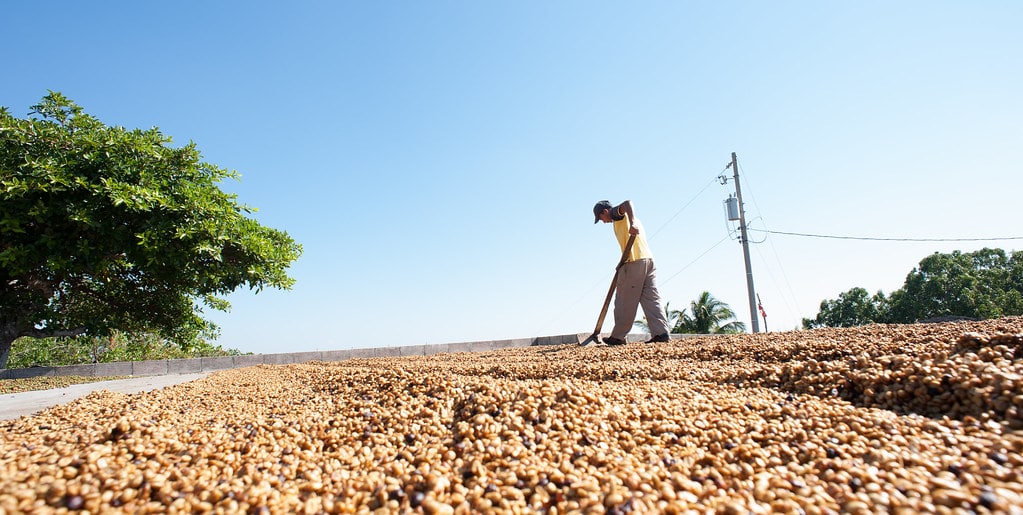
Dry processing is a type of coffee processing that involves drying the freshly picked coffee cherry (fruit) in the sun for some time on large patios while repeatedly raking and turning the drying cherry until the green coffee beans are generally free of any dried fruit and the humidity content is about 10.5 percent. Instead of sun-drying, automatic dryers can be used.
Then either the dried fruit is disposed of as waste, or if there are services, it can now be refined into coffee flour.
Through this method, while the coffees acquire unique flavors, it’s also a risky bet–it takes at least 2 weeks without sun to allow for drying. Rain or high humidity contributes to mold and fungus growth and can kill a crop–sometimes the entire income of a farmer.
Dry processed coffees tend not to have a vast array of flavors, as the coffee cherry always pushes the flavor toward fruity and sweetness. Nevertheless, dry processing is essential for Brazilian, Ethiopian, and Yemeni coffees.
Another critical consideration is the amount of water required–dry-processed coffees can use as little as one gallon per kilogram of dried parchment. In contrast, wet processing takes more than 10 gallons per kilogram of dried parchment.
Coffee parchment (pergamino; pergaminho) is the resulting product. The residual fruit on the dry-processed coffee adds more body to the brewed coffee beverage, while wet-processed (washed) coffees appear to have a more desirable acidity level.
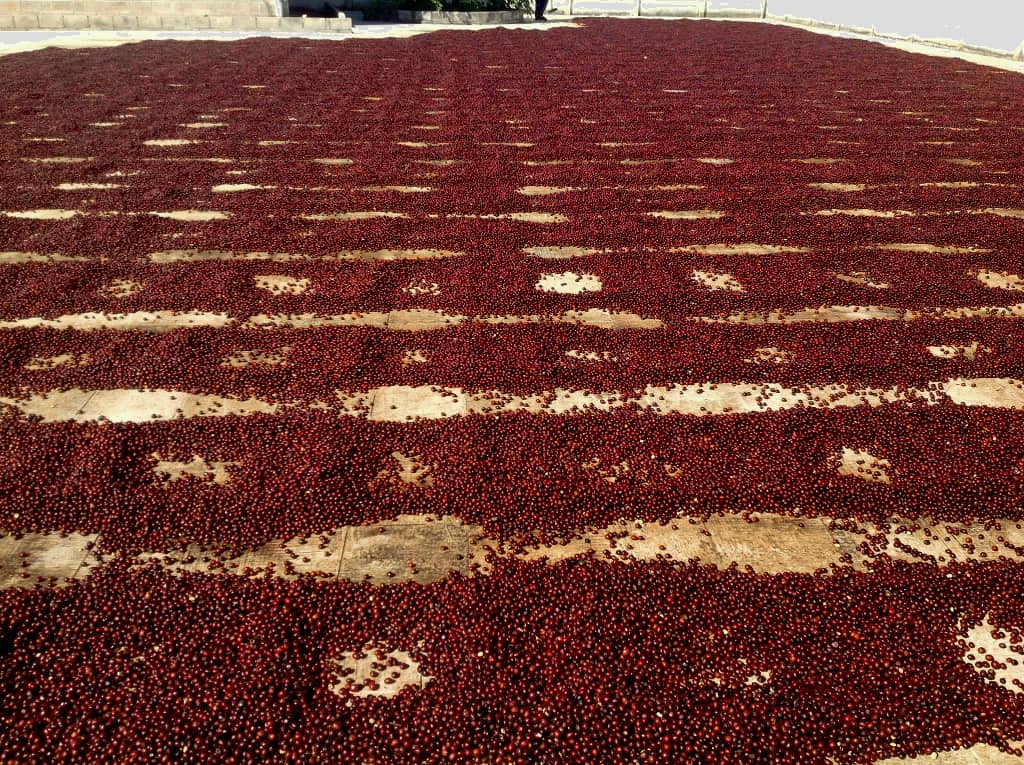
A benefit of the dry processing method is that because the fruit remains left in with the coffee beans, the brewed coffee tends to have more body than wet-processed coffee.
Most coffee experts think wet-processed coffees are superior to nonunwashed (dry-processed; natural) coffee, but this is simply a preference.
Sometimes known as “pulped natural,” “semi-washed,” “dry milled,” or “honey coffee.”
Pulped natural/semi-dry / honey process
The pulped natural or “semi-dry” process involves extracting various portions of the coffee cherry– between Wet Processing and Dry Processing. Recently, these varying amounts have become known respectively as “black honey,” “red honey,” and “yellow honey”–more of the coffee cherry left on the outside results in a more caramelizing and darker color. Less coffee cherry, on the other hand, means less sugar and a light hue.

What is “Pulped Natural” coffee processing?
Pulped Natural processing is a procedure that removes the coffee cherry’s outer skin to reveal the fruity layer and then helps it to dry in the sun (or with mechanical dryers sometimes). Between dry and wet processing, it is called halfway–taking more processing time and consuming more water than pure natural processing, but also providing a better quality cup.
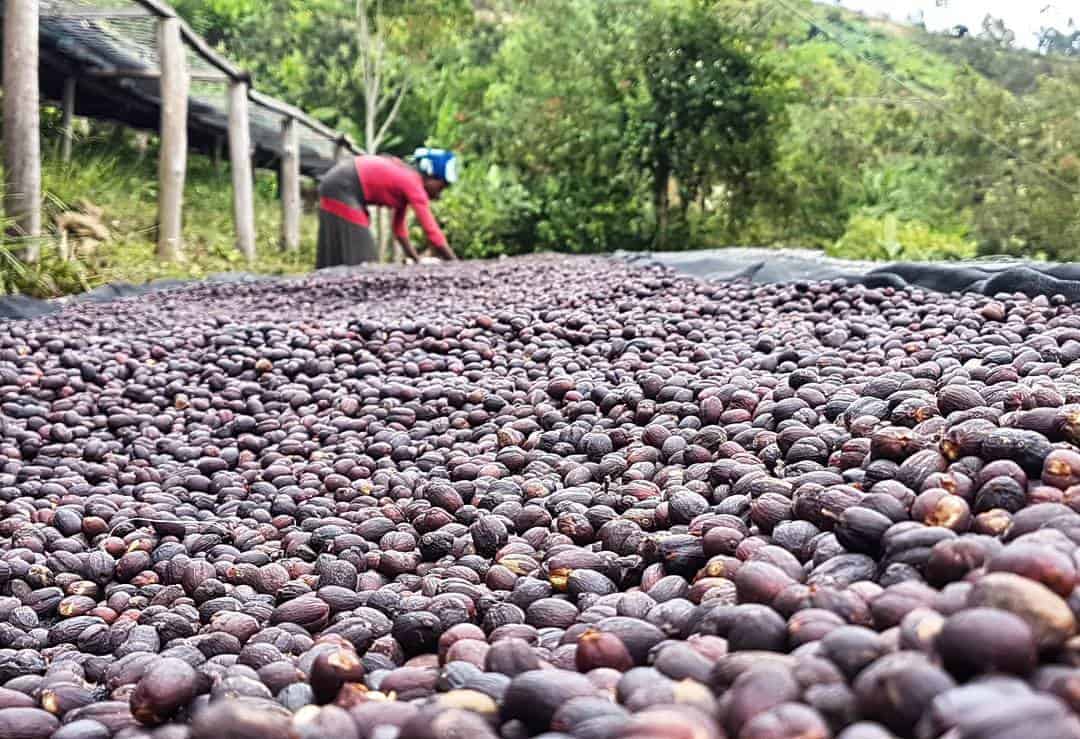
Pulping the coffee to remove the outer skin
The pulped natural processing method often used in Brazil, where strip-picking is the norm, involves first pulping the coffee to remove the outer skin. However, this is done without fermentation. Next, the coffee cherry is sun-dried on a raised drying bed or a patio, with much of the mucilage still attached.
The pulped coffee cherry can also be ground into a fine powder known as coffee flour and have a high nutritional content with plenty of potassium, fiber, and natural caffeine.
Regions where pulped natural processing is used
The processing method of pulped natural coffee works best in regions where humidity is low so that the mucilage of the coffee can be easily dried without fermentation. However, coffee must be turned periodically to prevent mildew, which can lead to mold and fungus.
Characteristics of coffee with pulped natural processing
The pulped natural method exhibits features of both wet processing method (good acidity) coffee and dry-processed green coffees (sweetness, body), with some of the full flavors of dry-processed coffee in the cup, comparable to wet-processed coffee.
Pulped Natural processing brings out the coffee’s natural sweetness and aromatics–if done correctly, it will result in a better coffee taste.
Wet hulled / Semi washed
Coffees are pulped at the farm using this method to strip the coffees down to parchment and mucilage, then sent to the processing facility. This is also known as “Giling Basah” (wet grinding) in Indonesian countries.
Usually, the processing technique is passed down within a country through generations, with current farmers doing something very close to what their fathers and grandfathers did, and so on. However, government and international coffee organizations sometimes step in to provide alternative methods or share their techniques, which helps raise industry-wide standards.
However, some methods are unavailable or too expensive–the processors may be limited in their options in areas where water is scarce or equipment is unavailable. So while it’s hard to imagine countries like Canada, the United States, the United Kingdom, and Australia in the first world, much of the coffee-growing world is constrained by a lack of knowledge and essential equipment.
What is “Semi-Washed” Coffee Processing?
Demucilaging in the Semi-Washed Processing Method
The semi-washed coffee processing method involves using a demucilage machine to strip the coffee cherry skin from the green coffee and some or most of the mucilage.
Characteristics of Coffee with Semi-Washed Processing
Coffee beans processed using the semi-washed method are similar to coffee processed using the natural pulped method. Like wet-processed coffee, it displays a bright, clean cup with less body than dry-processed coffee.
Pulping coffee
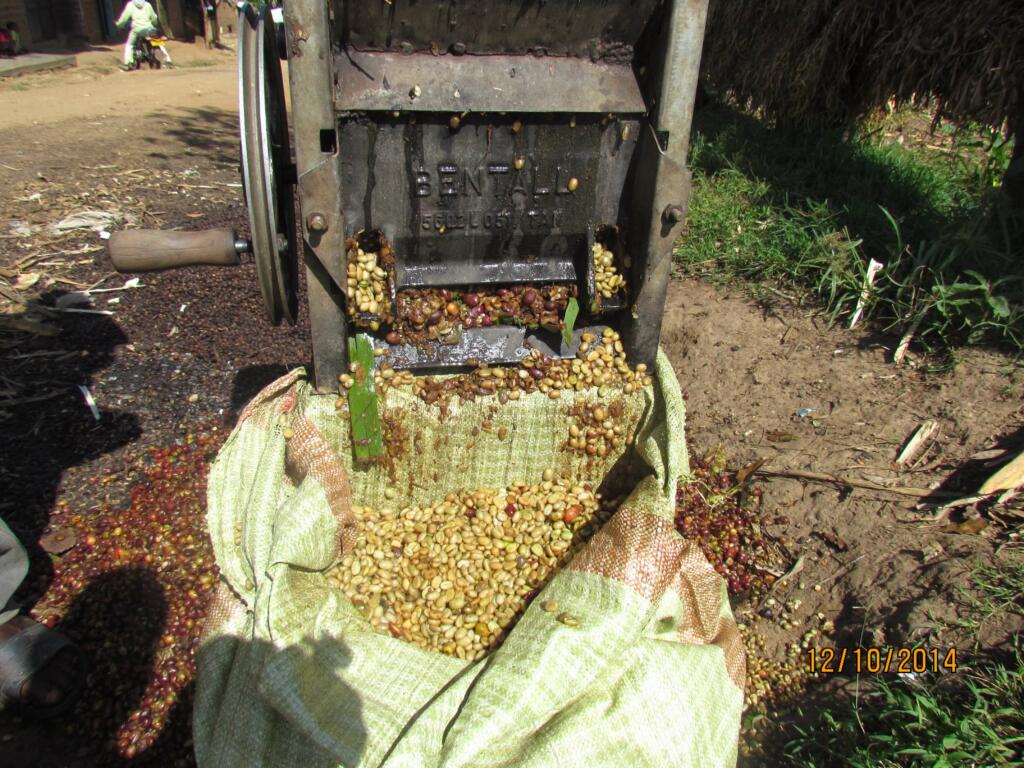
Pulping typically takes place within 24 hours after the coffee cherry (fruit) is harvested and involves removing the outer flesh of the coffee cherry (red skin and mucilaginous pulp). Typically this is achieved with a machine known as a pulper that loosens and splits the outer part of the cherry using rough rollers.
Demucilaging, drying, and hulling
Next, the mucilage of the coffee cherry is removed by fermentation by placing the cherry for 12 to 24 hours in a fermentation tank.
Then the coffee beans are dried by forced-air drying or spread over decks or patios (see hoshidana) to dry naturally in the sunlight (see sun-drying). After drying, coffee beans usually have a moisture content of about 10.5 percent.
Hulling/husking is performed with a huller that mills off the parchment and the silver skin and polishes the beans, known as green coffee beans at this point (milled but not yet roasted).
Aquapulp coffee processing
Aquapulp removes the sticky pulp or mucilage of the freshly-picked coffee cherry using mechanical demucilage, using machines to clean the cherry.
Gradually, the aquapulp process replaced conventional wet processing methods for extracting mucilage through fermentation and washing.
After removing the parchment, the coffee beans are sorted and graded based on local standards in different regions. The beans are generally sorted into grades of quality based on size, shape, and other factors. (See also Coffee Beans Grading.)
How do producers decide what process to use?
Most coffee growers strive to make the most profitable, and thus the best-tasting, coffee possible, but the environment constrains them. More than most consumables, coffee has a strong connection to its surroundings.
Producers frequently wait to see how much rain has fallen before deciding whether to manufacture washed, honey-roasted, or natural coffee. When it rains, it is more challenging to manufacture good natural process coffee because the coffee cherries can split. However, honey processing or natural processing conditions are ideal without rain because no sugars will be washed away.
What happens after the coffee is processed?
The parchment coating still surrounds the coffee beans after being prepared (unless they are giling basah processed). The moisture content of the beans is now low enough to be stored without spoiling. Before exporting, the beans are usually held in reposo (= dry warehouse) for 1-2 months. The beans are hulled just before shipment to remove the parchment.
In a dry mill, the hulling is done mechanically (as opposed to a wet mill / depulper in a washing process). After hulling, the beans are graded and sorted using machines that look at their size and color. The beans can also be separated by hand or using big sieves with varying hole diameters.
After being processed and graded, the beans are packed into 60kg or 69kg jute bags, depending on the place of origin. Finally, the jute bags are placed in a shipping container, protecting the beans on their journey to a roastery.
Grading coffee
Graduated hole sizing screens assist in completing the grading process. Also used are vibrating air tables, gravity dividing the beans by density, and isolating damaged (e.g., hollow or nicked) coffee beans that can affect the final product’s taste.
Criteria used for grading coffee beans
The grading of coffee beans is a rating of quality based on certain requirements.
The grading criteria may include coffee bean size, coffee bean hardness (e.g., density), rising altitude, color, fragrance, number of bean imperfections or defects (e.g., hollow, deformed, chipped, nicked, etc.), coffee bean type/plant type purity (e.g., botanical variety, variety), number of underripe beans and overripe beans, method of processing used to remove beans from coffee cheese.
Coffee grading methods by region
Every area that grows coffee has its method of grading coffee beans. It allows a country or region to take coffee from any number of farms–often hundreds or thousands–and produce a consistent product in other countries for coffee importers and brokers.
Screens with graduated hole sizing
Use screens with graduated hole sizing; coffee beans are often divided into quality groups, dividing the beans by size and shape.
A vibrating air table that uses gravity to separate and grade the beans by density is also used to grade the beans. This also isolates the defective coffee beans that may be nicknamed hollow or other imperfections. If these coffee beans are not removed, the overall quality of the coffee may be reduced.
Electronic and mechanical coffee bean grading
Electronic and mechanical grading–by scale, weight, shape, and color–occurs after the Kenya coffee beans are milled, and the best coffee beans are extracted. In contrast, faulty beans are removed, which may add off-taste to a coffee.
Clearing extraneous materials
This might also affect coffee bean grading if coffee beans were not cleaned of foreign materials during processing and sorting (e.g., removing all foreign matter such as pebbles, wood, insects, etc.). It is common to receive bulk bags of green coffee beans with foreign fragments, primarily benign and destroyed during roasting, even with proper processing.
Other coffee grading systems
Many countries use other coffee bean grading methods. However, with the introduction of new technology and machinery, the grading and processing of coffee beans have shown continuous improvement in coffee-growing regions worldwide for sorting.
Coffee silverskin
Many coffee processors that sell whole green coffee beans leave the silverskin on the bean as it acts as a protective barrier and then crumbles naturally during coffee roasting. Other coffee processors polish the silverskin.
Roasting coffee
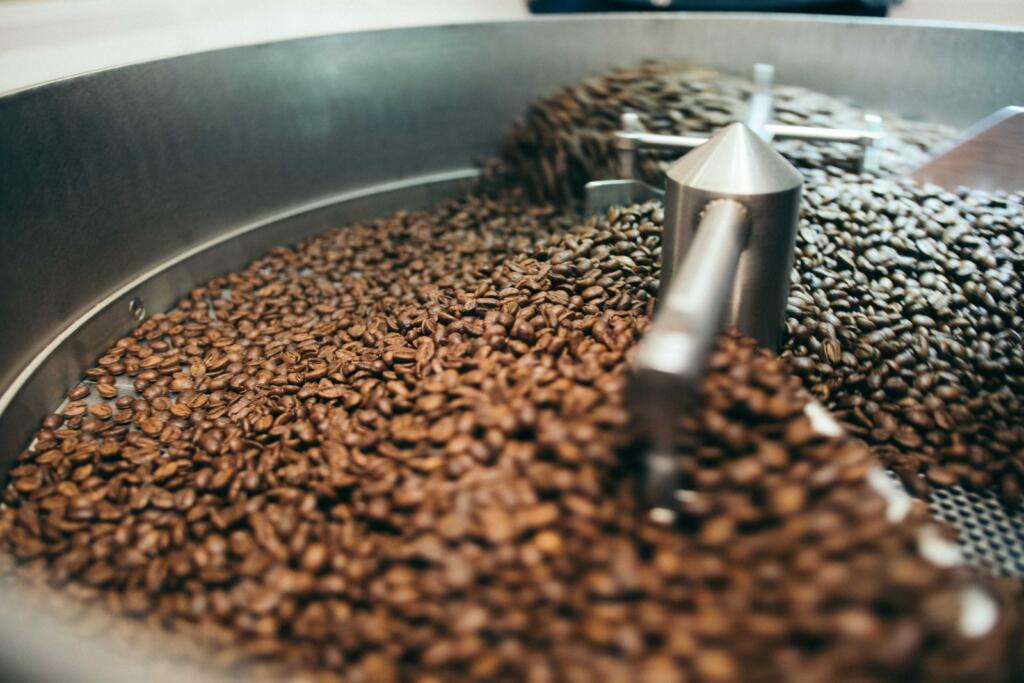
The final step in preparing coffee for consumption is roasting, which involves heating/cooking / drying coffee beans in a coffee roaster to alter the green coffee beans’ physical and chemical properties to achieve the desired flavors and aromas of the final cup of brewed coffee.
Coffee roasting removes most of the coffee beans’ moisture and starts a pyrolisis sequence chemical reaction. Such chemical reactions modify the coffee beans’ chemical composition and produce the coffee compounds associated with the brewed coffee’s flavors and aromas.
The professional roastmaster aims to apply the perfect roasting temperature for just the right amount of time to deliver the best flavors of the individually roasted coffee beans.
Roastmasters pay close attention to roasting coffee beans’ color level as they grow and change their hue. This is because the roasting coffee beans’ color varies from very light to dark, and their density often changes as coffee beans lose moisture.
Coffee roasting produces, modifies, and stabilizes the coffee beans’ scent and the body, flavor, sweetness/bitterness, acidity, and aroma of the brewed coffee in different aspects and instances.
Coffee roasting machines
As well as a proper coffee roaster, roasting coffee requires skill. Most roasting machines are heated using propane gas to drive a drum using electricity. Temperatures range from 370 ° Fahrenheit to 540 ° Fahrenheit (188 ° Celsius to 282 ° Celsius).
Roasting times vary from 12 to 30 minutes, and the beans shrink by weight by about 20 percent as they develop a dark flavor and aroma. Usually, 25 green coffee beans take about 15 minutes to roast, and 8 pounds of the coffee cherry is about 1 pound of roasted coffee (100 pounds of the coffee cherry is about 12 pounds of roasted coffee).
Fluid bed roasters
A Fluid Bed Roaster is a coffee roaster that uses a column of hot air to agitate and roast the green coffee beans. After Michael Sivetz invented it, the Fluid Bed Roaster, sometimes called a Sivetz Roaster, works much the same as a popcorn popper.
Roasting time
Total roasting time for coffee varies depending on several factors, including coffee bean quality, moisture content, and grade. In addition, the age of the coffee beans and the weather conditions in which the coffee roasting is done also affect the roasting time.
The type of roast required, ranging from Light Roast to Medium Roast to Semi-Dark Roast to Dark Roast, is a primary factor in determining coffee roasting time.
The skilled roastmaster pays attention to the roasting time and temperature and more subtle considerations such as the coffee beans’ appearance and fragrance during roasting.
The roastmaster listens to the roasting coffee beans’ popping or cracking noises–these distinct “cracks” occur during roasting at specific times.
Grinding
Once the coffee beans are roasted, they are ready for grinding and brewing.
Conclusion
There you go; you now know the different coffee processing methods. Learning about coffee farming and how it’s being processed while sipping your favorite coffee-type drink is a wonderful way to appreciate it daily.

Editorial Staff
The editorial staff at Crazy Coffee Crave is a team of coffee enthusiasts & Baristas who enjoy the one thing we all think about as soon as we get up in the morning. Trusted by thousands of readers worldwide.




